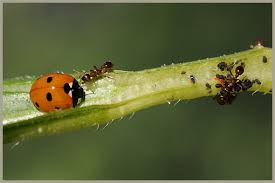Green and black aphids (Aphidoidea) suck nutrients (of growth points) of plants. Their secretion is called honeydew. The fungi that thrive there are called sooty mold.
Honeydew is for ants, wasps and bees feeding. Ants protect and milk aphids. They keep them as we keep cattle.
There are 4,400 species.
 The larva of a ladybug eats an average of 600 aphids. An adult ladybug can eat about 100 aphids per day.
The larva of a ladybug eats an average of 600 aphids. An adult ladybug can eat about 100 aphids per day.
Also, ichneumon wasps (Ichneumonidae) and their larvae are natural enemies of aphids. The earwig (Forficula auricularia) is an omnivore that besides aphids also mites, larvae and eggs of insects, small caterpillars and other pests eats like plant foods as well as algae. Give them some tubes, or cram straw and leaves as shelter, and they stay in your fruit tree. (In peach trees this does not work, because earwigs like to eat peach).
Spraying can with soapy water, or alcohol, or both. Or an infusion of onions, rhubarb leaves, onion leaves, elder or tobacco leaf, nettle vulture: pick a big bunch of nettles, preferably young (best with gloves) and put them in a bucket of water for a week. Filter and then spray the stuff on the lousy plants. After twice spraying the lice are usually gone.
Or let one kg of leaf cook for 20 minutes in 2 liters of water, add a tablespoon of mild soap, strain, and dilute 1 to 4.
Marigold attract insects that control aphids.
Crushing some groups of aphids would tress their natural enemies.
Spraying with an extract of tomato leaves, or a clove of garlic in the ground can also deter aphids.
If you want to debug a harvested lettuce you can put it under saltwater an hour, then rinse. (This also works for caterpillars in cauliflower or broccoli.)
If lice are not sprayed eating one may do no harm. (See also <Eating insects >)
|
Symptoms |
Insects |
|
Small round holes on leaf and stem base of herbaceous plant |
Nature caterpillar (larva of various moths)) |
|
Messy holes and damage to new shoots. |
Bugs |
|
Round gasp from the leaf edges |
(black) vine weevils (Otiorhynchus sulcatus)) |
|
Withered grass and loose turf grubs |
(larvae of cockchafer (Melolontha melolontha) and June beetle) |
|
Round bare spots in lawn |
leatherjackets (larvae of crane flies) |
The common (European) earwig (Forficula auricularia) is an insect of the order earwigs (Dermaptera).
These omnivorous lust soft parts of plants and vegetables, eggs and larvae of insects, especially aphids, mites and other parasites as well. The fruit they eat is often affected by other insects, cracks or diseases.
Earwigs are nocturnal and hide during the day under stones, wood or in cavities. Would you like them as aphids eaters(in fruit), then supply housing: hang an inverted flower pot filled with straw. They need to survive a certain degree of humidity.
Male earwigs have on the abdomen long, curved forceps, females smaller and almost straight pliers. They cannot stab or wound us, and they do not contain poison.
Distance is not a problem because the earwig can fly (a little). He has ingeniously built, very thin, semicircular, leathery wings behind which he can fold open like a fan by using the rod at the abdomen. They do not get off the ground, but they can go down to 'fly' from a height.
The females lay 60 round, pearly white eggs in a nest in the top 5 cm of the soil. The mother licks them regularly to keep them free of fungi and other microorganisms. Even after hatching, they will continue to take care of the offspring. This brood care is highly unusual in the insect world.
If the mother dies, she is eaten by her own offspring. A little earwig raises his armor off 4 times before it matures after 70 days.
Despite the name it is not creeping into our ear.
